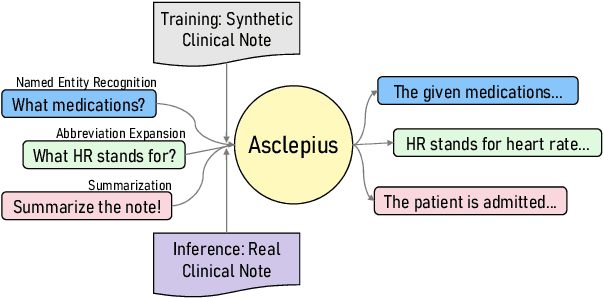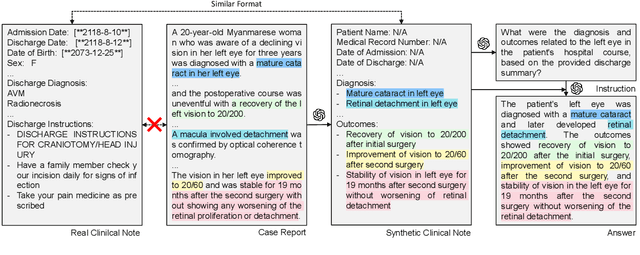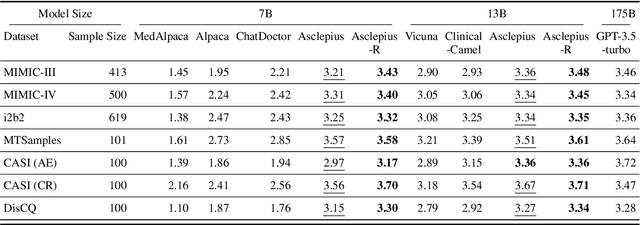Seongsu Bae
PatientSim: A Persona-Driven Simulator for Realistic Doctor-Patient Interactions
May 23, 2025Abstract:Doctor-patient consultations require multi-turn, context-aware communication tailored to diverse patient personas. Training or evaluating doctor LLMs in such settings requires realistic patient interaction systems. However, existing simulators often fail to reflect the full range of personas seen in clinical practice. To address this, we introduce PatientSim, a patient simulator that generates realistic and diverse patient personas for clinical scenarios, grounded in medical expertise. PatientSim operates using: 1) clinical profiles, including symptoms and medical history, derived from real-world data in the MIMIC-ED and MIMIC-IV datasets, and 2) personas defined by four axes: personality, language proficiency, medical history recall level, and cognitive confusion level, resulting in 37 unique combinations. We evaluated eight LLMs for factual accuracy and persona consistency. The top-performing open-source model, Llama 3.3, was validated by four clinicians to confirm the robustness of our framework. As an open-source, customizable platform, PatientSim provides a reproducible and scalable solution that can be customized for specific training needs. Offering a privacy-compliant environment, it serves as a robust testbed for evaluating medical dialogue systems across diverse patient presentations and shows promise as an educational tool for healthcare.
AOR: Anatomical Ontology-Guided Reasoning for Medical Large Multimodal Model in Chest X-Ray Interpretation
May 05, 2025Abstract:Chest X-rays (CXRs) are the most frequently performed imaging examinations in clinical settings. Recent advancements in Large Multimodal Models (LMMs) have enabled automated CXR interpretation, enhancing diagnostic accuracy and efficiency. However, despite their strong visual understanding, current Medical LMMs (MLMMs) still face two major challenges: (1) Insufficient region-level understanding and interaction, and (2) Limited accuracy and interpretability due to single-step reasoning. In this paper, we empower MLMMs with anatomy-centric reasoning capabilities to enhance their interactivity and explainability. Specifically, we first propose an Anatomical Ontology-Guided Reasoning (AOR) framework, which centers on cross-modal region-level information to facilitate multi-step reasoning. Next, under the guidance of expert physicians, we develop AOR-Instruction, a large instruction dataset for MLMMs training. Our experiments demonstrate AOR's superior performance in both VQA and report generation tasks.
EHRCon: Dataset for Checking Consistency between Unstructured Notes and Structured Tables in Electronic Health Records
Jun 24, 2024



Abstract:Electronic Health Records (EHRs) are integral for storing comprehensive patient medical records, combining structured data (e.g., medications) with detailed clinical notes (e.g., physician notes). These elements are essential for straightforward data retrieval and provide deep, contextual insights into patient care. However, they often suffer from discrepancies due to unintuitive EHR system designs and human errors, posing serious risks to patient safety. To address this, we developed EHRCon, a new dataset and task specifically designed to ensure data consistency between structured tables and unstructured notes in EHRs. EHRCon was crafted in collaboration with healthcare professionals using the MIMIC-III EHR dataset, and includes manual annotations of 3,943 entities across 105 clinical notes checked against database entries for consistency. EHRCon has two versions, one using the original MIMIC-III schema, and another using the OMOP CDM schema, in order to increase its applicability and generalizability. Furthermore, leveraging the capabilities of large language models, we introduce CheckEHR, a novel framework for verifying the consistency between clinical notes and database tables. CheckEHR utilizes an eight-stage process and shows promising results in both few-shot and zero-shot settings. The code is available at https://github.com/dustn1259/EHRCon.
Overview of the EHRSQL 2024 Shared Task on Reliable Text-to-SQL Modeling on Electronic Health Records
May 04, 2024Abstract:Electronic Health Records (EHRs) are relational databases that store the entire medical histories of patients within hospitals. They record numerous aspects of patients' medical care, from hospital admission and diagnosis to treatment and discharge. While EHRs are vital sources of clinical data, exploring them beyond a predefined set of queries requires skills in query languages like SQL. To make information retrieval more accessible, one strategy is to build a question-answering system, possibly leveraging text-to-SQL models that can automatically translate natural language questions into corresponding SQL queries and use these queries to retrieve the answers. The EHRSQL 2024 shared task aims to advance and promote research in developing a question-answering system for EHRs using text-to-SQL modeling, capable of reliably providing requested answers to various healthcare professionals to improve their clinical work processes and satisfy their needs. Among more than 100 participants who applied to the shared task, eight teams completed the entire shared task processes and demonstrated a wide range of methods to effectively solve this task. In this paper, we describe the task of reliable text-to-SQL modeling, the dataset, and the methods and results of the participants. We hope this shared task will spur further research and insights into developing reliable question-answering systems for EHRs.
EHRXQA: A Multi-Modal Question Answering Dataset for Electronic Health Records with Chest X-ray Images
Oct 28, 2023



Abstract:Electronic Health Records (EHRs), which contain patients' medical histories in various multi-modal formats, often overlook the potential for joint reasoning across imaging and table modalities underexplored in current EHR Question Answering (QA) systems. In this paper, we introduce EHRXQA, a novel multi-modal question answering dataset combining structured EHRs and chest X-ray images. To develop our dataset, we first construct two uni-modal resources: 1) The MIMIC- CXR-VQA dataset, our newly created medical visual question answering (VQA) benchmark, specifically designed to augment the imaging modality in EHR QA, and 2) EHRSQL (MIMIC-IV), a refashioned version of a previously established table-based EHR QA dataset. By integrating these two uni-modal resources, we successfully construct a multi-modal EHR QA dataset that necessitates both uni-modal and cross-modal reasoning. To address the unique challenges of multi-modal questions within EHRs, we propose a NeuralSQL-based strategy equipped with an external VQA API. This pioneering endeavor enhances engagement with multi-modal EHR sources and we believe that our dataset can catalyze advances in real-world medical scenarios such as clinical decision-making and research. EHRXQA is available at https://github.com/baeseongsu/ehrxqa.
Publicly Shareable Clinical Large Language Model Built on Synthetic Clinical Notes
Sep 06, 2023



Abstract:The development of large language models tailored for handling patients' clinical notes is often hindered by the limited accessibility and usability of these notes due to strict privacy regulations. To address these challenges, we first create synthetic large-scale clinical notes using publicly available case reports extracted from biomedical literature. We then use these synthetic notes to train our specialized clinical large language model, Asclepius. While Asclepius is trained on synthetic data, we assess its potential performance in real-world applications by evaluating it using real clinical notes. We benchmark Asclepius against several other large language models, including GPT-3.5-turbo and other open-source alternatives. To further validate our approach using synthetic notes, we also compare Asclepius with its variants trained on real clinical notes. Our findings convincingly demonstrate that synthetic clinical notes can serve as viable substitutes for real ones when constructing high-performing clinical language models. This conclusion is supported by detailed evaluations conducted by both GPT-4 and medical professionals. All resources including weights, codes, and data used in the development of Asclepius are made publicly accessible for future research.
KU-DMIS-MSRA at RadSum23: Pre-trained Vision-Language Model for Radiology Report Summarization
Jul 10, 2023Abstract:In this paper, we introduce CheXOFA, a new pre-trained vision-language model (VLM) for the chest X-ray domain. Our model is initially pre-trained on various multimodal datasets within the general domain before being transferred to the chest X-ray domain. Following a prominent VLM, we unify various domain-specific tasks into a simple sequence-to-sequence schema. It enables the model to effectively learn the required knowledge and skills from limited resources in the domain. Demonstrating superior performance on the benchmark datasets provided by the BioNLP shared task, our model benefits from its training across multiple tasks and domains. With subtle techniques including ensemble and factual calibration, our system achieves first place on the RadSum23 leaderboard for the hidden test set.
ECG-QA: A Comprehensive Question Answering Dataset Combined With Electrocardiogram
Jun 21, 2023Abstract:Question answering (QA) in the field of healthcare has received much attention due to significant advancements in natural language processing. However, existing healthcare QA datasets primarily focus on medical images, clinical notes, or structured electronic health record tables. This leaves the vast potential of combining electrocardiogram (ECG) data with these systems largely untapped. To address this gap, we present ECG-QA, the first QA dataset specifically designed for ECG analysis. The dataset comprises a total of 70 question templates that cover a wide range of clinically relevant ECG topics, each validated by an ECG expert to ensure their clinical utility. As a result, our dataset includes diverse ECG interpretation questions, including those that require a comparative analysis of two different ECGs. In addition, we have conducted numerous experiments to provide valuable insights for future research directions. We believe that ECG-QA will serve as a valuable resource for the development of intelligent QA systems capable of assisting clinicians in ECG interpretations.
EHRSQL: A Practical Text-to-SQL Benchmark for Electronic Health Records
Jan 16, 2023



Abstract:We present a new text-to-SQL dataset for electronic health records (EHRs). The utterances were collected from 222 hospital staff, including physicians, nurses, insurance review and health records teams, and more. To construct the QA dataset on structured EHR data, we conducted a poll at a university hospital and templatized the responses to create seed questions. Then, we manually linked them to two open-source EHR databases, MIMIC-III and eICU, and included them with various time expressions and held-out unanswerable questions in the dataset, which were all collected from the poll. Our dataset poses a unique set of challenges: the model needs to 1) generate SQL queries that reflect a wide range of needs in the hospital, including simple retrieval and complex operations such as calculating survival rate, 2) understand various time expressions to answer time-sensitive questions in healthcare, and 3) distinguish whether a given question is answerable or unanswerable based on the prediction confidence. We believe our dataset, EHRSQL, could serve as a practical benchmark to develop and assess QA models on structured EHR data and take one step further towards bridging the gap between text-to-SQL research and its real-life deployment in healthcare. EHRSQL is available at https://github.com/glee4810/EHRSQL.
Graph-Text Multi-Modal Pre-training for Medical Representation Learning
Mar 18, 2022



Abstract:As the volume of Electronic Health Records (EHR) sharply grows, there has been emerging interest in learning the representation of EHR for healthcare applications. Representation learning of EHR requires appropriate modeling of the two dominant modalities in EHR: structured data and unstructured text. In this paper, we present MedGTX, a pre-trained model for multi-modal representation learning of the structured and textual EHR data. MedGTX uses a novel graph encoder to exploit the graphical nature of structured EHR data, and a text encoder to handle unstructured text, and a cross-modal encoder to learn a joint representation space. We pre-train our model through four proxy tasks on MIMIC-III, an open-source EHR data, and evaluate our model on two clinical benchmarks and three novel downstream tasks which tackle real-world problems in EHR data. The results consistently show the effectiveness of pre-training the model for joint representation of both structured and unstructured information from EHR. Given the promising performance of MedGTX, we believe this work opens a new door to jointly understanding the two fundamental modalities of EHR data.
 Add to Chrome
Add to Chrome Add to Firefox
Add to Firefox Add to Edge
Add to Edge